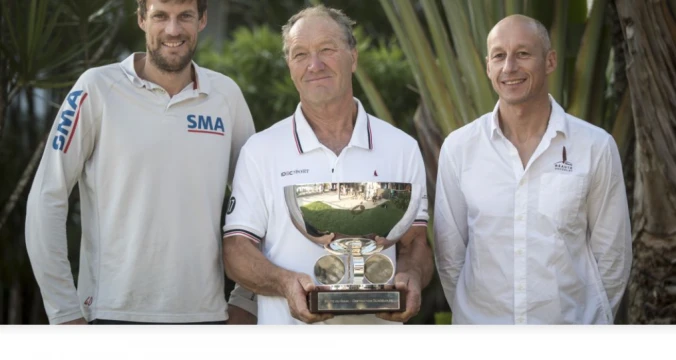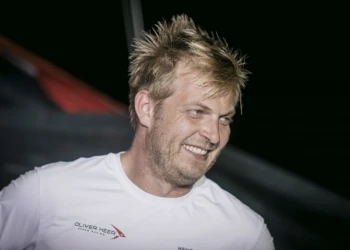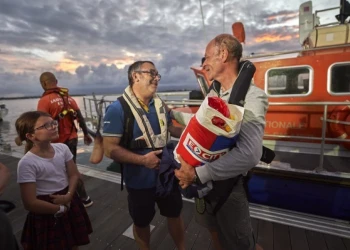
First winners at the Route du Rhum 40th anniversary
Route du Rhum: an absolute classic 40th anniversary race
The 40th anniversary and 11th edition of the Route du Rhum-Destination Guadeloupe is not over yet – there are still plenty of intrepid Class40 and Rhum class skippers making their way to the Caribbean – but we now have winners in all six classes and the overall shape of the race is starting to emerge.
Looking back over 18 days of competition, occasional drama and a lot of blood, sweat and tears, it is quite clear that this has been an absolute classic Route du Rhum-Destination Guadeloupe that has only enhanced its status as one of the key races in the solo ocean racing calendar, alongside The Transat and the Vendée Globe solo round-the-world race.
The beauty of this contest is the way it combines a brutal start in the cold, disturbed autumnal air of the north Atlantic and Bay of Biscay with the easier and warmer conditions of the trade winds. But a notable feature this time is just how challenging the north-easterly trades have been for many skippers.
The notion that once they had survived the series of depressions of the first 10 days, it would all be plain sailing to Pointe-à-Pitre has proved far from the case. The trade wind has been boisterous, squally and unpredictable and many of the leading skippers have found the final days to the finish extremely wearing as they battled exhaustion and often contending with auto-pilots struggling to keep boats on track.
Re-winding back to Saint Malo, who could forget the extraordinary turnout from the French public at the race village during the 10-day build-up to race start? Over a million people toured the pontoons eager for a glimpse of the boats and their skippers and the media were there in numbers to rival an Olympic regatta. The Route du Rhum-Destination Guadeloupe start village has a unique atmosphere with Caribbean hospitality and music infusing every hour of the day and night.
The contrast for the skippers could hardly have been more stark as they left the cheering crowds behind and then suddenly found themselves alone on the ocean and facing extremely tough conditions. In the early days we saw dismastings, boats breaking, a notable capsize (Armel Le Cleac’h) and a good proportion of the record-setting 123-strong fleet taking the prudent decision to seek shelter on the French and Spanish coasts and who could blame them?
Out on the Biscay and eastern fringes of the Atlantic, the breeze was gusting to over 50 knots in the worst of the storms and it was during this phase that the contenders for the podium in each of the six classes emerged.
In ULTIMES it was François Gabart and Francis Joyon; in Multi50s Armel Tripon; in IMOCAS Alex Thomson, Paul Meilhat, Yann Eliès and Vincent Riou; in Class40s Yoann Richomme, Phil Sharp and Aymeric Chapellier, and in the Rhum classes, Sidney Gavignet in Monos and Pierre Antoine in Multis.
These were sailors who were able to cope with the physical and psychological onslaught of three successive storm systems while keeping their boats on track but, at the same time, not breaking them. It was a test of experience and seamanship and for many of those chasing them it would prove a tough school in which to learn.
So what have been the stand-out performances? Well, it is difficult to look further than the remarkable transatlantic match-race between Joyon and Gabart who put on a master-class on the fastest ocean-going sailing boats in the world. They made something difficult and dangerous look easy. Some might say that the course should be changed to avoid going around the leeward side of Basse-Terre at the death, but it presented the same challenge for both sailors and Joyon – a living legend of the sport – used all his guile to sneak past the superstar of the younger generation.
In Multi50s Tripon was always in contention as he and Lalou Roucayrol speared off towards the Portuguese coast together, leaving a group chasing them further to the west. Unlike most of his rivals Tripon did not stop, kept his boat together and ended up a convincing winner.
In the IMOCA class we witnessed the biggest drama of the race when Alex Thomson threw it all away within 70 miles of the finish having – up until then – sailed a masterful and dominant race. But his sportsmanship in the face of humiliation at the finish was exemplary. In that class, Thomson apart, the outstanding performance was by the skipper who inherited the win – Paul Meilhat - who drove his older-generation boat like a man possessed and who must surely now find a slot for the next Vendée Globe.
If Meilhat did not put a foot wrong, the same could be said of Richomme in Class40s who led almost from the start and never gave his opponents a look-in. This was a supremely well-prepared sailor in the fastest boat in the fleet and the combination was lethal. Behind him Sharp and Chapellier could only fight for the minor places. In the two Rhum class amateur fleets, meanwhile, experience shone through with two veterans, Gavignet and Antoine, showing how it should be done and emerging as convincing winners.
While records in almost all classes have been broken, the preparedness of many of the sailors to share their adventures with us has made this a thrilling sporting event. One element that has come across loud and clear is just what a huge and life-changing undertaking the Route du Rhum-Destination Guadeloupe is for almost all who take part in it. It requires months of preparation and then a steely determination once the starting gun has been fired.
There are still many stories to tell – not least by the marvellous Loïc Peyron who is steadily closing on the finish line on board his little yellow trimaran, and Éric Bellion who is trundling across the Atlantic on his big schooner. I have also been keeping an eye on Dominque Dubois who has doggedly kept to his task on his 50ft monohull despite enduring what looked like a horrendous first 10 days in the Biscay. All of them will be winners when they get to Guadeloupe, even if they do so after the finishing line has officially closed.





